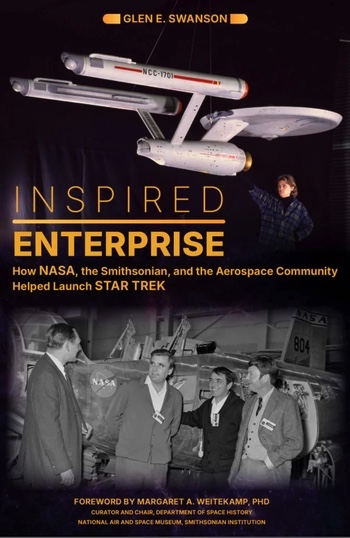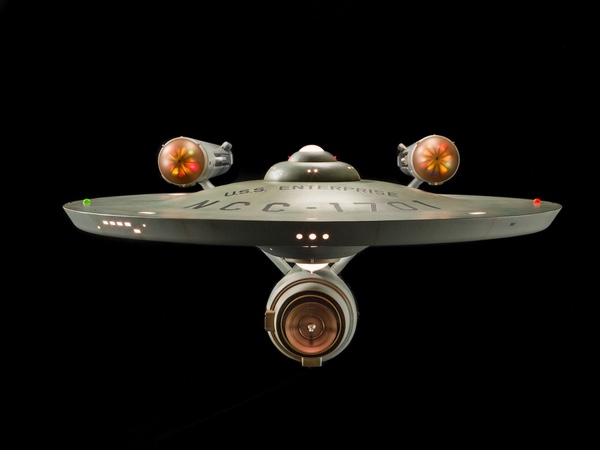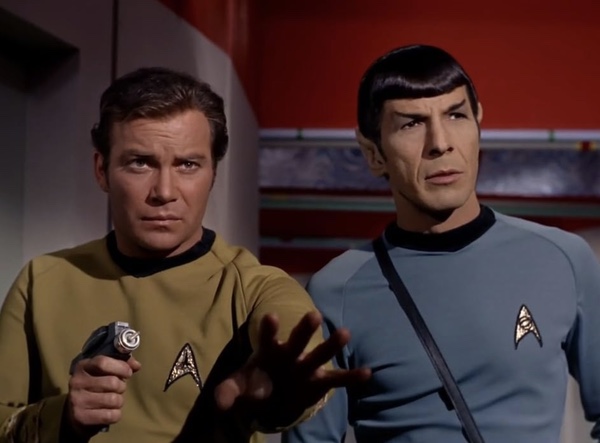Is Starfleet military or scientific? Yes.by Dwayne A. Day
|
| The show used military ranks and hierarchy, and was heavily modeled upon the US Navy. But the Starfleet in Star Trek had a scientific mission that at least rivaled its military one. |
The dichotomy of Starfleet in many ways mirrors the American space program. Early depictions of an American space program in the 1950s portrayed it as a military mission, with scientific support. Popular movies often portrayed a Space Corps sending astronauts into space. This close relationship was also mirrored in reality—for example, the V-2 rockets that the United States Army captured and brought to the United States were launched in the American southwestern desert by Army personnel with scientific payloads. Congress, particularly Senate Majority Leader Lyndon Johnson, wanted a civilian space agency. President Eisenhower, who had long familiarity with the military and did not inherently trust it, agreed that after Sputnik, the United States should have a civilian space agency, named NASA.
 A new book by Glen Swanson explores the ties between Star Trek, the military, the aerospace community, and the Smithsonian Institution. |
Star Trek and the military
In his book, Swanson writes:
Starting with the first season, terms such as “Star Service,” “Spacefleet Command,” “United Earth Space Probe Agency,” and “Space Central” were used to refer to the operating authority that owned the Enterprise and governed her crew. In the series’ second pilot, “Where No Man Has Gone Before,” an “academy” is mentioned (though not “Starfleet”) along with reference to “The Service.” In the episode “Mudd’s Women,” the show established that captains, like their modern-day counterparts, have authority to convene a board of inquiry. It wasn’t until the fourteenth episode, “Court Martial,” that audiences first heard the term “Starfleet.” The third edition of the Star Trek Writers Guide, which came out near the end of the first season, stated that “the USS Enterprise is a spaceship, official designation ‘starship class’; somewhat larger than a present-day naval cruiser, it is the largest and most modern type vessel in the Starfleet Service.
Star Trek had other links to the military, some of them very esoteric. As Swanson wrote: Jack Hartley, “a lieutenant colonel in the Air Force, wrote a book on dental standards for the selection and examination of space crewmen. He also was an avid Star Trek fan.” Hartley later was in contact with Gene Roddenberry, and may have contributed to or inspired some of the medical devices seen in the show.
In 1968, the Air Force’s prestigious Aerospace Pilot Research School, located at Edwards Air Force Base, California, where NASA obtained some of its first astronauts, invited Shatner and Nimoy to attend the graduation exercises of its class of 1967. The invitation read “The staff and students will be wearing their Air Force winter mess dress uniforms,” as written by Colonel Eugene P. Deatrick, commandant of the school, “and we would be pleased if Messrs. Shatner and Nimoy would wear their Star Ship dress uniforms.” Shatner and Nimoy could not attend.
Despite these early ties, over the decades, Star Trek sometimes wrestled with the subject, not only on screen, but behind the scenes. For instance, the 1982 movie Star Trek II: The Wrath of Khan was directed by outsider director Nicolas Meyer, who sought a more nautical look and feel to the movie, something that Roddenberry objected to. When Roddenberry became producer of the series Star Trek: The Next Generation in 1986, he wanted to portray Starfleet as much more of an exploration organization. His new Enterprise looked more like a cruise ship than a warship, and even had families aboard. Roddenberry wanted the crew’s phasers to look less like guns and more like non-threatening instruments, earning them the nickname “dustbusters” because they looked like they were intended to clean between sofa cushions, not disintegrating Klingons. After Roddenberry’s death, several of the shows included storylines about major wars, something that Roddenberry had opposed featuring during his tenure.
| Starfleet has a dual mission, two core missions that often live in conflict with each other: to peacefully explore space and expand the bounds of human knowledge, and to defend the interests of the Federation. |
Recently, an episode of the latest Star Trek series, Strange New Worlds, sought to take on this question that has run through the franchise’s six decades and hundreds of episodes. The episode “What is Starfleet?” was presented as a documentary where several of the crew of the starship Enterprise were confronted with the question of whether Starfleet is a noble organization with the primary goal of exploration, or just a military organization trying to justify its existence.
The episode presented the Enterprise crew with a dilemma: they are assigned to transport a weapon of mass destruction to a planet to assist it in a war so that planet can join the Federation. But it turns out that the weapon is actually a subjugated sentient lifeform. What is the Enterprise’s mission, to protect the Federation, or to seek out new life and behave morally when encountering it? The episode was not satisfying to many reviewers. Although it concluded with the Starfleet crew doing the moral thing, the story took shortcuts to get there.
The episode took on an issue that had been inherent to the show since it first aired in 1966, although never fully settled. In Star Trek, Starfleet has a dual mission, two core missions that often live in conflict with each other: to peacefully explore space and expand the bounds of human knowledge, and to defend the interests of the Federation.
 The starship Enterprise was on an exploration mission, but also equipped with weapons. (credit: National Air and Space Museum) |
NASA and the military
NASA was created as a civilian agency in 1958 rather than part of the military. Over many decades, it has been primarily, even overwhelmingly, civilian in its goals and operations. Although NASA space shuttles did launch some military satellites during the 1980s and 1990s, its primary mission has always been science and exploration, with national defense left to the military and their space agencies, most recently the Space Force. This has enabled NASA to engage in diplomatic efforts, like the International Space Station.
NASA always had a close relationship with the military, including using military launch ranges and support services. During the Apollo years, a senior military official, General Sam Phillips, was on loan to the agency to manage the program. American spacecraft were recovered at sea by US Navy vessels. But NASA was clearly civilian, with the military assisting; NASA was not performing military missions.
| NASA always had a close relationship with the military. But NASA was clearly civilian, with the military assisting; NASA was not performing military missions. |
NASA also benefited from using classified intelligence technology. The Lunar Orbiter spacecraft used technology developed for the Samos reconnaissance satellites. NASA also had a program named the Lunar Mapping and Survey System that used a converted reconnaissance camera, but never actually flew. Sometimes this relationship became strained, as the intelligence community was wary of the civilian space agency drawing too much attention to classified reconnaissance technology.
But the issue has recently come into the news because of a new presidential executive order that stipulates that NASA will now “have as a primary function intelligence, counterintelligence, investigative, or national security work.” This appears not to be a result in a change in NASA’s mission. Any change in NASA’s mission would require a change in its charter via an act of Congress. Much more recently, the NASA acting administrator has been proposing that NASA be incorporated into the Department of Transportation—is Starfleet is military or scientific, will NASA be military or transportation?
As Star Trek—both on screen, and in the writer’s room—has demonstrated, this conflict will probably persist, maybe for centuries.
Note: we are now moderating comments. There will be a delay in posting comments and no guarantee that all submitted comments will be posted.
